Non-Invasive Analyses of Italian “Ostrogothic” Jewellery: The Desana Treasure
Abstract
:1. Introduction
- it derives from a long and complex period of selection, accumulation and use;
- it provides a consistent sample of the main regional guidelines in the evolution of jewellery over more than one hundred years;
- it displays evident connections with «global» fashions, to their production centres and to the trade networks lying underneath them.
2. Materials and Methods
2.1. UV-Visible Diffuse Reflectance Spectrophotometry with Optic Fibres (FORS)
2.2. X-ray Fluorescence Spectrometry (XRF)
- ~30 ppm for elements >Fe;
- 100 ppm for elements between Cl and Mn;
- 150 ppm for S (in absence of Pb);
- 300 ppm for P;
- 3000 ppm for Si;
- 6000 ppm for Al;
- 5% for Mg (excluded from processing in this work).
2.3. Optical Microscopy
3. Results
- the gemstones, present in blue, green, red and violet colours;
- the glasses, present in blue and green colour;
- the gold alloys.
3.1. Gemstones
3.1.1. Blue Gemstones
3.1.2. Green Gemstones
- a rod bracelet (object no. 8/Ori);
- a bracelet with articulated elements (object no. 10/Ori);
- a pendant earring (object no. 16/Ori);
- a ring with a smooth emerald (object no. 19/Ori);
- a necklace (object no. 20/Ori);
- a fragment of necklace (object no. 21/Ori);
- a ring with a carved emerald (object no. 29/Ori).
- the emeralds of the bracelets no. 8/Ori and no. 10/Ori appear to have a composition matching the Pakistani quarries, according to the content of Fe (respectively 1.11 and 1.22% as FeO) and Cr (0.84 and 0.95% as Cr2O3);
- the emeralds of the earring no. 16/Ori, the ring no. 19/Ori and the necklace no. 20/Ori have a composition fitting the Egyptian origin;
- the emerald of the ring no. 29/Ori has a composition resembling that of an Indian source;
- finally, the three emeralds of the necklace no. 21/Ori show three apparently different compositions, compatible, respectively, with Egyptian, Indian and Austrian (Habachtal) sources.
3.1.3. Red Gemstones
- a rod bracelet (object no. 8/Ori);
- a bracelet or diadem with articulated elements (object no. 10/Ori);
- a pair of polyhedral earrings (object no. 13/Ori);
- a necklace (object no. 20/Ori);
- a ring with engraved garnet (object no. 23/Ori);
- a ring with smooth garnet (object no. 24/Ori);
- a cloisonné bow brooch (object no. 30/Ori);
- a cloisonné bow brooch (object no. 31/Ori);
- a gold bezel with garnet (object no. 135/Ori);
- a belt buckle (object no. 382/A).
- type I, almandine from Rajasthan, India;
- type II, calcium-rich almandine from India;
- type IIIA, calcium-poor pyrope-almandine from Central Sri Lanka;
- type IIIB, calcium-poor pyrope-almandine from South Sri Lanka;
- type IV, chrome poor pyrope from Monte Suímo, Portugal;
- type V, chrome-rich pyrope from Bohemia, Czech Republic.
3.1.4. Violet Gemstones
- a bracelet with articulated elements (object no. 10/Ori);
- a bulla-shaped capsella (object no. 11/Ori);
- a necklace (object no. 20/Ori).
3.1.5. Other Gemstones
3.2. Glasses
3.2.1. Blue Glasses
- the eye of the griffin in the cochlear (object no. 379/A);
- the eye of the fish in a ligula (object no. 364/A);
- two eyes on tip in a ligula (object no. 364/A).
3.2.2. Green Glasses
- a rod bracelet (object no. 8/Ori);
- the eye of the fish in a ligula (object no. 362/A);
- the eye of the fish in a ligula (object no. 363/A).
3.3. Gold Alloys
- an openwork bracelet (object no. 9/Ori);
- a crossbow brooch (object no. 12/Ori);
- a pair of polyhedral earrings (object no. 14/Ori);
- a pair of wire earrings (object no. 17/Ori);
- a fragmentary wire earring (object no. 18/Ori);
- a wedding ring (object no. 25/Ori);
- a cross-shaped pendant (object no. 26/Ori);
- a finger ring with personal name (object no. 27/Ori);
- a finger ring with monogram (object no. 28/Ori).
4. Discussion
5. Conclusions
Author Contributions
Funding
Institutional Review Board Statement
Informed Consent Statement
Data Availability Statement
Acknowledgments
Conflicts of Interest
References
- Degani, M. Il Tesoro Romano Barbarico di Reggio Emilia; Sansoni: Firenze, Italy, 1959. [Google Scholar]
- Bierbrauer, V. Die Ostgotischen Funde von Domangnano, Republik San Marino (Italien). Germania 1973, 51, 499–523. [Google Scholar]
- Bierbrauer, V. Die Ostgotischen Grab- und Schatzfunde in Italien; Biblioteca; Centro italiano di studi sull’alto Medioevo: Spoleto, Italy, 1975. [Google Scholar]
- Bierbrauer, V. Reperti Ostrogoti Provenienti Da Tombe o Tesori Della Lombardia. In I Longobardi e la Lombardia; Azzimonti: Milano, Italy, 1978; pp. 213–240. [Google Scholar]
- Manière-Lévêque, A.M. L’évolution Des Bijoux “Aristocratiques” Féminins à Travers Les Trésors Proto-Byzantins d’orfèvrerie. Rev. Archéologique 1997, 1, 79–106. [Google Scholar]
- Baldini Lippolis, I. L’oreficeria Nell’impero di Costantinopoli Tra IV e VII Secolo; Bibliothec; Edipuglia: Bari, Italy, 1999. [Google Scholar]
- Aimone, M. Il Tesoro Di Desana. Una Fonte per Lo Studio Della Società Romano-Ostrogota in Italia; BAR Intern; Archaeopress: Oxford, UK, 2010. [Google Scholar]
- Baldini Lippolis, I.; Pinar Gil, J. Osservazioni Sul Tesoro Di Reggio Emilia. In Proceedings of the Ipsam Nolam Barbari Vastaverunt: L’Italia e il Mediterraneo Occidentale tra il V Secolo e la Metà del VI, Cimitile-Nola-Santa Maria Capua Vetere, Cimitile, Italy, 18–19 June 2009; Ebanista, C., Rotili, M., Eds.; atti del Convegno Internazionale di Studi. Tavolario: Cimitile, Italy, 2010; pp. 113–128. [Google Scholar]
- AA.VV. Royal Insignia of the Late Antiquity from Mšec and Řevničov, Bohemia; Jiřík, J., Ed.; V.M.Press: Písek, Czech Republic, 2023. [Google Scholar]
- Yatsuk, O.; Ferretti, M.; Gorghinian, A.; Fiocco, G.; Malagodi, M.; Agostino, A.; Gulmini, M. Data from Multiple Portable XRF Units and Their Significance for Ancient Glass Studies. Molecules 2022, 27, 6068. [Google Scholar] [CrossRef] [PubMed]
- Aceto, M.; Calà, E.; Gulino, F.; Gullo, F.; Labate, M.; Agostino, A.; Picollo, M. The Use of UV-Visible Diffuse Reflectance Spectrophotometry for a Fast, Preliminary Authentication of Gemstones. Molecules 2022, 27, 4716. [Google Scholar] [CrossRef] [PubMed]
- De Michele, V.; Aceto, M.; Agostino, A.; Fenoglio, G. La Gemmatura Nella Pace Di Chiavenna. Arte Lomb. 2019, 185, 72–80. [Google Scholar] [CrossRef]
- Gorelick, L.; Gwinnett, A.J. Diamonds from India to Rome and Beyond. Am. J. Archaeol. 1988, 92, 547–552. [Google Scholar] [CrossRef]
- Gwinnett, A.J.; Gorelick, L. A Brief History of Drills and Drilling. BEADS J. Soc. Bead Res. 1998, 10–11, 49–56. [Google Scholar]
- Palanza, V.; Di Martino, D.; Paleari, A.; Spinolo, G.; Prosperi, L. Micro-Raman Spectroscopy Applied to the Study of Inclusions within Sapphire. J. Raman Spectrosc. 2008, 39, 1007–1011. [Google Scholar] [CrossRef]
- Palke, A.C.; Saeseaw, S.; Renfro, N.D.; Sun, Z.; McClure, S.F. Geographic Origin Determination of Blue Sapphire. Gems Gemol. 2019, 55, 536–579. [Google Scholar] [CrossRef]
- Farges, F.; Panczer, G.; Benbalagh, N.; Riondet, G. The Grand Sapphire of Louis XIV and the Ruspoli Sapphire: Historical and Gemological Discoveries. Gems Gemol. 2016, 51, 392–409. [Google Scholar] [CrossRef]
- Schneider, H. Kosmas Indikopleustes, Christliche Topographie. Textkritische Analysen. Übersetzung. Kommentar; Brepols Publishers: Turnhout, Italy, 2011. [Google Scholar]
- Al-Beruni, M. The Book Most Comprehensive in Knowledge on Precious Stones; Said, H.M., Ed.; Adam Publisher: New Delhi, India, 2007. [Google Scholar]
- Barone, G.; Mazzoleni, P.; Bersani, D.; Raneri, S. Portable XRF: A Tool for the Study of Corundum Gems. Open Archaeol. 2017, 3, 194–201. [Google Scholar] [CrossRef]
- Kochelek, K.A.; McMillan, N.J.; McManus, C.E.; Daniel, D.L. Provenance Determination of Sapphires and Rubies Using Laser-Induced Breakdown Spectroscopy and Multivariate Analysis. Am. Mineral. 2015, 100, 1921–1931. [Google Scholar] [CrossRef]
- Scarani, A.; Åström, M. Gemological Applications of UV-Vis-NIR Spectroscopy. Riv. Ital. Gemmol. 2017, 7, 1–9. [Google Scholar]
- Saeseaw, S.; Renfro, N.D.; Palke, A.C.; Sun, Z.; McClure, S.F. Geographic Origin Determination of Emerald. Gems Gemol. 2019, 55, 614–646. [Google Scholar] [CrossRef] [Green Version]
- Karampelas, S.; Al-Shaybani, B.; Mohamed, F.; Sangsawong, S.; Al-Alawi, A. Emeralds from the Most Important Occurrences: Chemical and Spectroscopic Data. Minerals 2019, 9, 561. [Google Scholar] [CrossRef]
- Giuliani, G.; Groat, L.A.; Marshall, D.; Fallick, A.E.; Branquet, Y. Emerald Deposits: A Review and Enhanced Classification. Minerals 2019, 9, 105. [Google Scholar] [CrossRef]
- Aurisicchio, C.; Conte, A.M.; Medeghini, L.; Ottolini, L.; De Vito, C. Major and Trace Element Geochemistry of Emerald from Several Deposits: Implications for Genetic Models and Classification Schemes. Ore Geol. Rev. 2018, 94, 351–366. [Google Scholar] [CrossRef]
- Guerra, M.F.; Calligaro, T.; Perea, A. The Treasures of Guarrazar: Tracing the Gold Suppies in the Visigothic Iberian Peninsula. Archaeometry 2007, 49, 53–74. [Google Scholar] [CrossRef]
- Aurisicchio, C.; Corami, A.; Ehrman, S.; Graziani, G.; Cesaro, S.N. The Emerald and Gold Necklace from Oplontis, Vesuvian Area, Naples, Italy. J. Archaeol. Sci. 2006, 33, 725–734. [Google Scholar] [CrossRef]
- Pliny the Elder The Natural History. Available online: http://data.perseus.org/citations/urn:cts:latinLit:phi0978.phi001.perseus-eng1:35.26 (accessed on 30 December 2022).
- Schmetzer, K.; Gilg, H.A.; Schüssler, U.; Panjikar, J.; Calligaro, T.; Périn, P. The Linkage Between Garnets Found in India at the Arikamedu Archaeological Site and Their Source at the Garibpet Deposit. J. Gemmol. 2017, 35, 598–627. [Google Scholar] [CrossRef]
- Pion, C.; Gratuze, B.; Périn, P.; Calligaro, T. Bead and Garnet Trade between the Merovingian, Mediterranean, and Indian Worlds. In The Oxford Handbook of The Merovingian World; Effros, B., Moreira, I., Eds.; Oxford University Press: Oxford, UK, 2020; pp. 819–859. [Google Scholar]
- Van Grieken, R.E.; Markowicz, A.A. Handbook of X-ray Spectrometry, 2nd ed.; Marcel Dekker: New York, NY, USA, 2002. [Google Scholar]
- Rousseau, R. Detection Limit and Estimate of Uncertainty of Analytical XRF Results. Rigaku J. 2001, 18, 33–46. [Google Scholar]
- Gilg, H.A.; Schmetzer, K.; Schussler, U. An Early Byzantine Engraved Almandine from the Garibpet Deposit, Telengana State, India: Evidence for Garnet Trade Along the Ancient Maritime Silk Road. Gems Gemol. 2018, 54, 149–165. [Google Scholar] [CrossRef]
- Raman, K.V. Further Evidence of Roman Trade from Costal Sites in Tamil Nadu. In Rome and India: The Ancient Sea Trade; Begley, V., De Puma, R.D., Eds.; University of Wisconsin Press: Madison, WI, USA, 1991; pp. 125–133. [Google Scholar]
- Krzemnicki, M.S.; Butini, F.; Butini, E.; De Carolis, E. Gemmological Analysis of a Roman Sapphire Intaglio and Its Possible Origin. J. Gemmol. 2019, 36, 710–724. [Google Scholar] [CrossRef]
- Krzemnicki, M.S.; Hänni, H.A.; Guggenheim, R.; Mathys, D. Investigations on Sapphires from an Alkali Basalt, South West Rwanda. J. Gemmol. 1996, 25, 90–106. [Google Scholar] [CrossRef]
- Gübelin, E.J.; Koivula, J.I. Photoatlas of Inclusions in Gemstones, Volume 3; Opinio Publishers: Basel, Switzerland, 2008. [Google Scholar]
- Hänni, H.; Schubiger, B.; Kiefert, L.; Häberli, S. Raman Investigations on Two Historical Objects from Basel Cathedral: The Reliquary Cross and Dorothy Monstrance. Gems Gemol. 1998, 34, 102–125. [Google Scholar] [CrossRef] [Green Version]
- Reiche, I.; Pages-Camagna, S.; Lambacher, L. In Situ Raman Spectroscopic Investigations of the Adorning Gemstones on the ReliquaryHeinrich’s Cross from the Treasury of Basel Cathedral. J. Raman Spectrosc. 2004, 35, 719–725. [Google Scholar] [CrossRef]
- Agostino, A.; Aceto, M.; Fenoglio, G.; Operti, L. Caratterizzazione Chimica Della Coperta Del Codice C. In Tabula ornata lapidibus diversorum colorum. La legatura preziosa del Codice C nel Museo del Tesoro del Duomo di Vercelli; Lomartire, S., Ed.; Viella: Roma, Italy, 2015; pp. 125–162. ISBN 9788867285907. [Google Scholar]
- Superchi, M. Le Gemme Dell’Evangeliario Di Ariberto. In Evangeliario di Ariberto; Tomei, A., Ed.; Silvana Editore: Milano, Italy, 1999; pp. 149–157. [Google Scholar]
- Robotti, S.; Rizzi, P.; Soffritti, C.; Garagnani, G.L.; Greco, C.; Facchetti, F.; Borla, M.; Operti, L.; Agostino, A. Reliability of Portable X-ray Fluorescence for the Chemical Characterisation of Ancient Corroded Copper-tin Alloys. Spectrochim. Acta Part B At. Spectrosc. 2018, 146, 41–49. [Google Scholar] [CrossRef]
- Beck, L.; Bosonnet, S.; Réveillon, S.; Eliot, D.; Pilon, F. Silver Surface Enrichment of Silver–Copper Alloys: A Limitation for the Analysis of Ancient Silver Coins by Surface Techniques. Nucl. Instrum. Methods Phys. Res. Sect. B Beam Interact. Mater. At. 2004, 226, 153–162. [Google Scholar] [CrossRef]
- Corsi, J.; Lo Giudice, A.; Re, A.; Agostino, A.; Barello, F. Potentialities of X-ray Fluorescence Analysis in Numismatics: The Case Study of Pre-Roman Coins from Cisalpine Gaul. Archaeol. Anthropol. Sci. 2018, 10, 431–438. [Google Scholar] [CrossRef]
- Aceto, M.; Agostino, A.; Labate, M. Analisi Chimica Non Invasiva Del “Tesoro Di Como”. Not. Portale Numis. Dello Stato 2022, 16, 223–231. [Google Scholar]
- Calligaro, T.; Périn, P. Une Nouvelle Étape Dans La Connaissance Des Grenats de l’orfèvrerie Mérovingienne. Analyse Géochimique et Provenance Des Grenats Ornant Les Chefs-d’oeuvre de l’orfèvrerie Mérovingienne Conservés Au Département Des Monnaies, Médailles et an-Tiques de La Bi. Antiq. Natl. 2022, 52, 42–71. [Google Scholar]
- Ross, M.C. Catalogue of the Byzantine and Early Mediaeval Antiquities in the Dumbarton Oaks Collection, Vol. 2, Jewelry, Enamels and Art of the Migration Period; Dumbarton Oaks: Washington, DC, USA, 1965. [Google Scholar]
- Baratte, F.; Lang, J.; La Nièce, S.; Metzger, C. Le Trésor de Carthage. Contribution à l’étude de L’orfèvrerie de l’Antiquité Tardive; CNRS Editions: Paris, France, 2002. [Google Scholar]
- Drauschke, J. Byzantine Jewellery? Amethyst Beads in East and West during the Early Byzantine Period. In Intelligible Beauty: Recent Research on Byzantine Jewellery; Entwistle, C., Adams, N., Eds.; British Museum Press: London, UK, 2010; pp. 50–60. [Google Scholar]
- Pinar Gil, J. Local Realities and Continental-Wide Fashions. Some Paradoxes on 5th-6th Century Clothing Ornamenta in the Western Mediterranean Provinces (and Beyond). In Political Fragmentation and Cultural Coherence in Late Antiquity; Boschung, D., Danner, M., Radtki, C., Eds.; Wilhelm Fink: Munich, Germany; Paderborn, Germany, 2015; pp. 249–290. [Google Scholar]
- Pinar Gil, J. Barbarian Jewellery, Social Space, Urban Culture. A Contribution to Fashion Theory in the Early Migration Period (Western Europe, ca. 400-480 AD). Slov. Archaeol. 2021, 69, 55–97. [Google Scholar] [CrossRef]
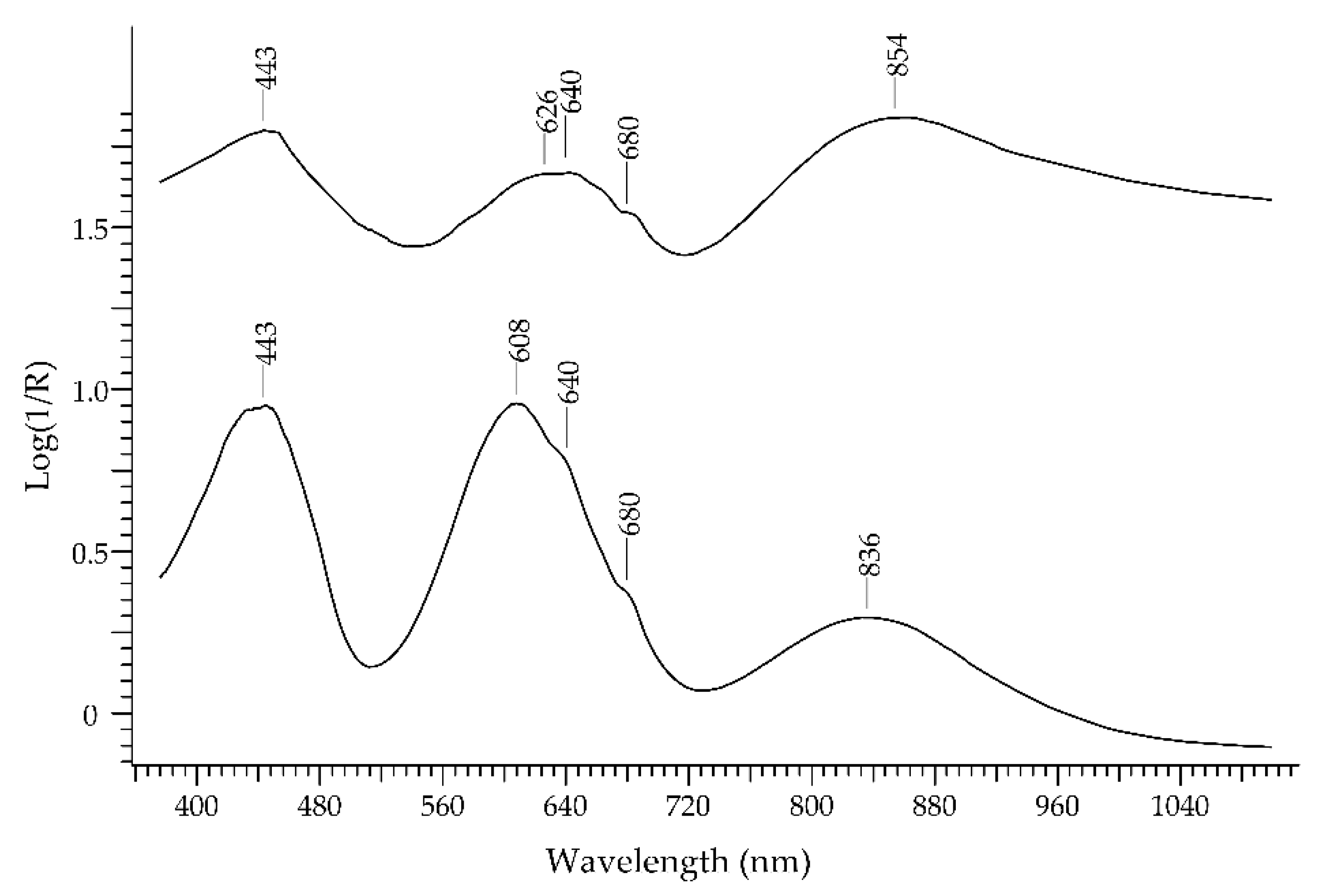
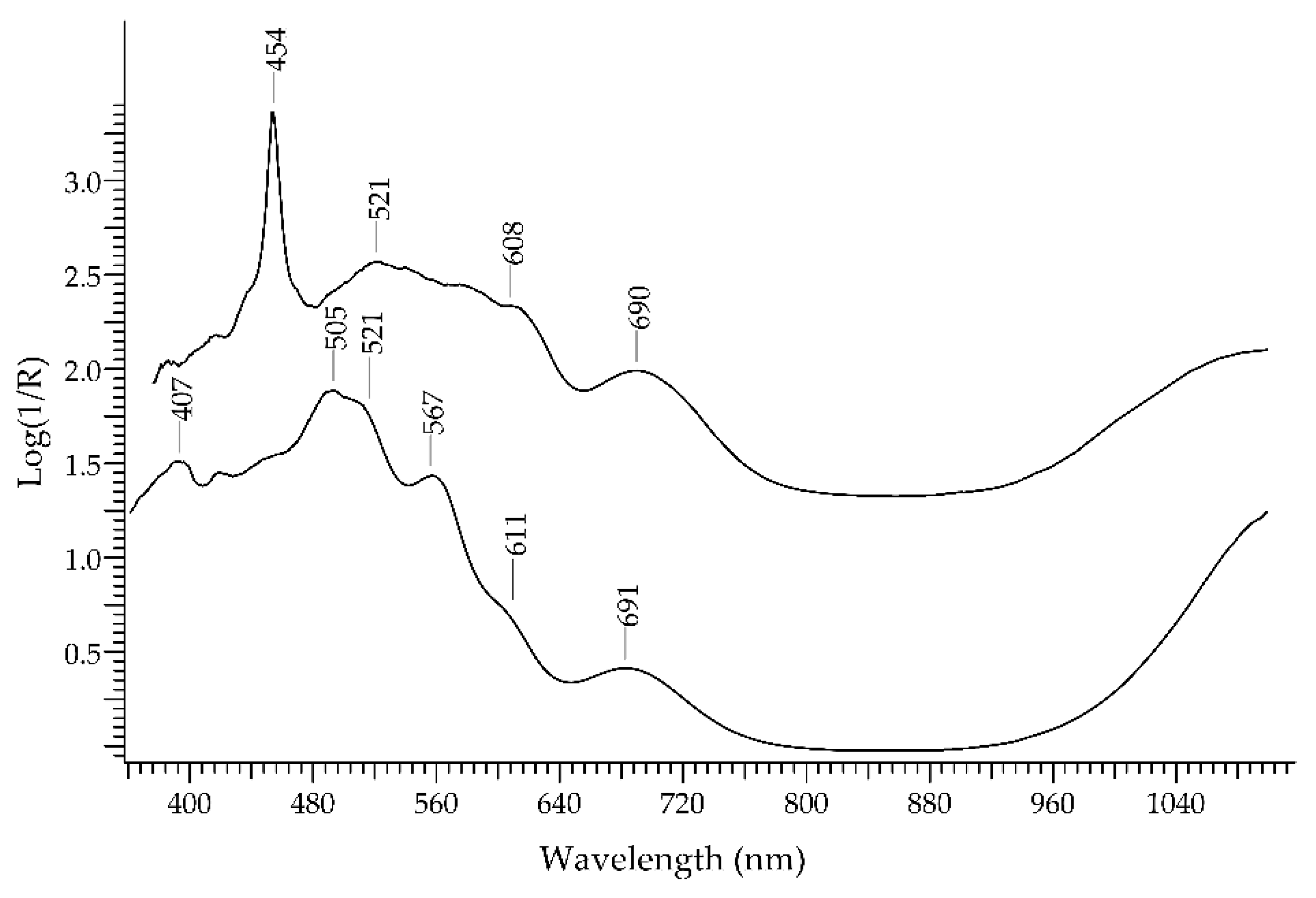
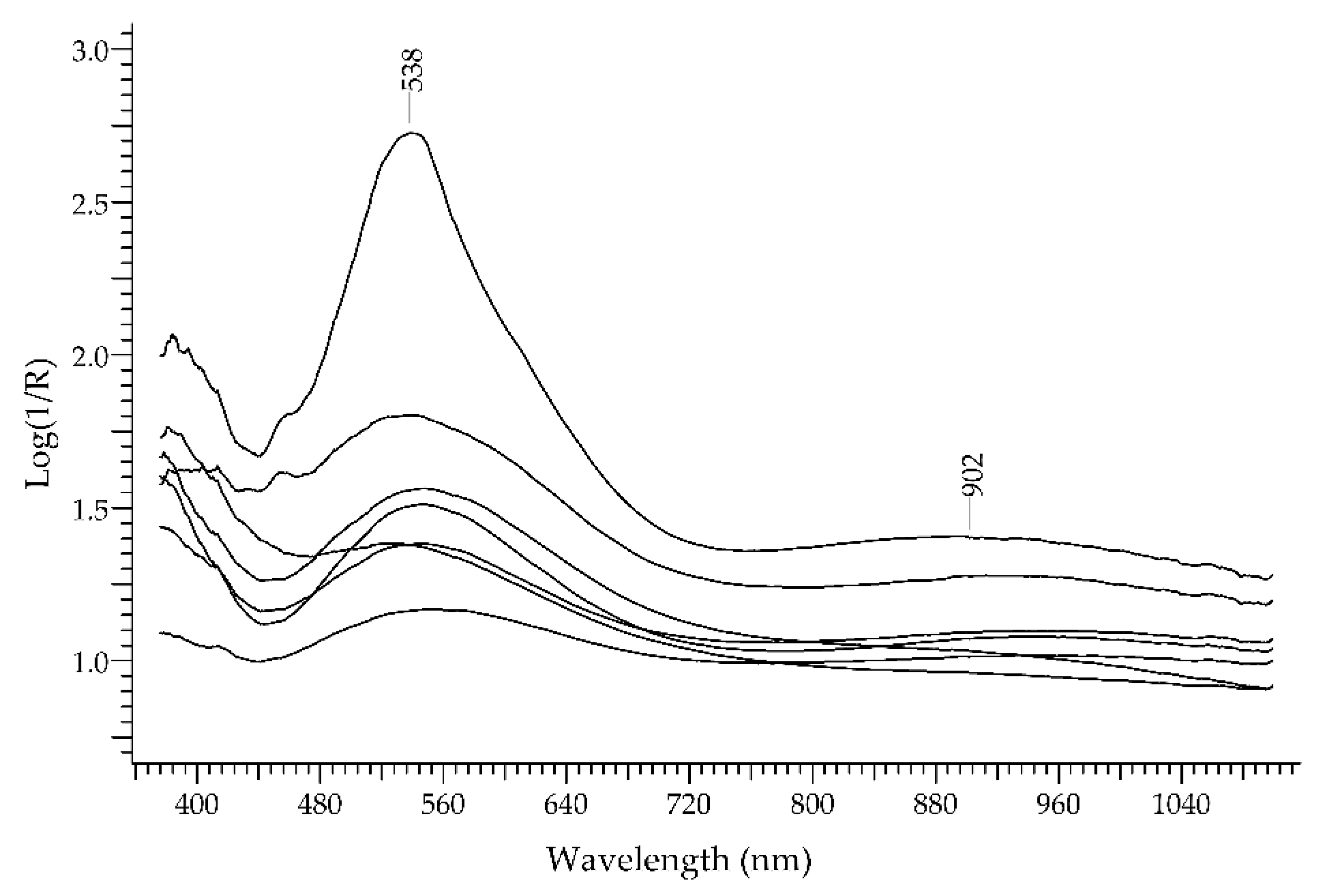
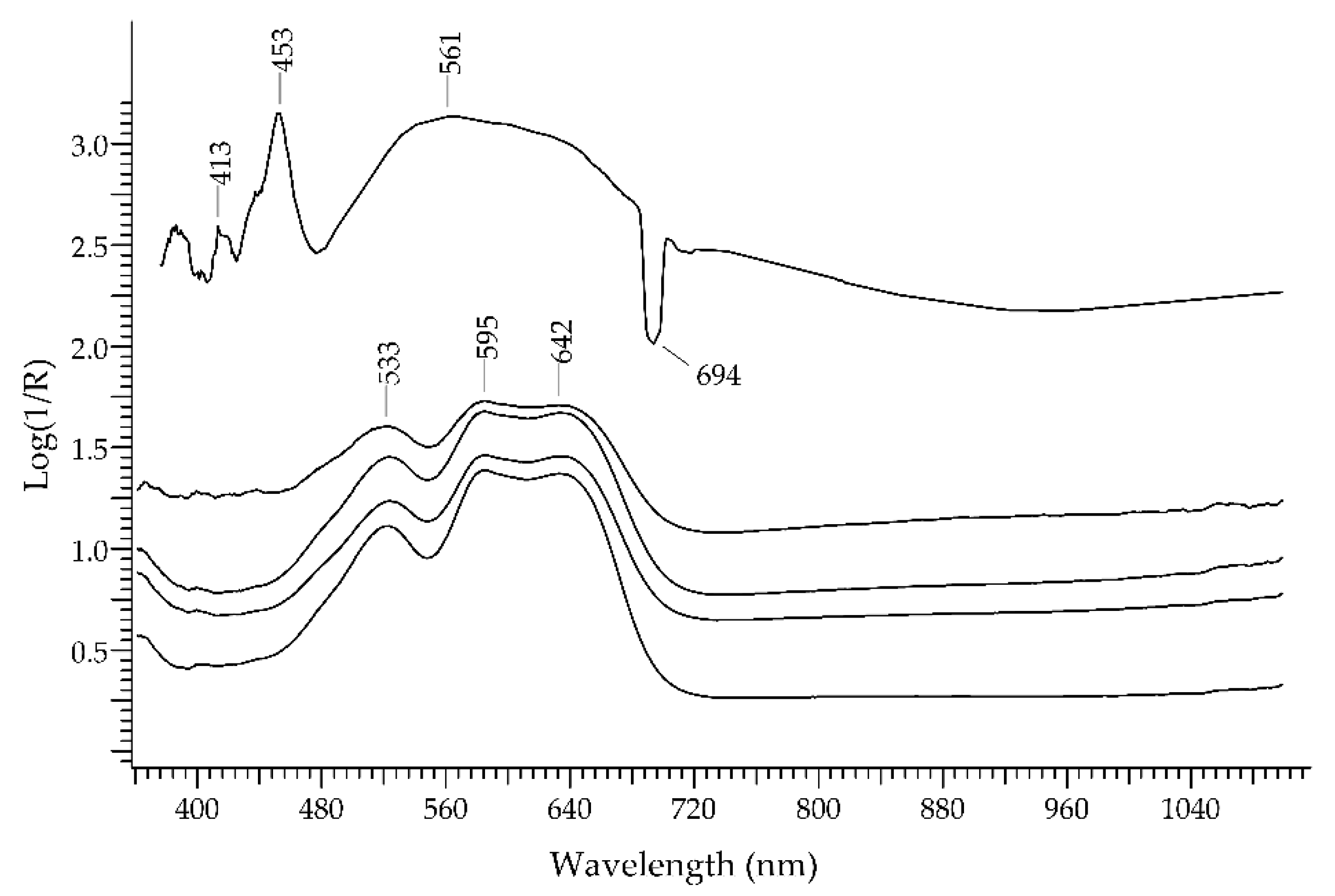
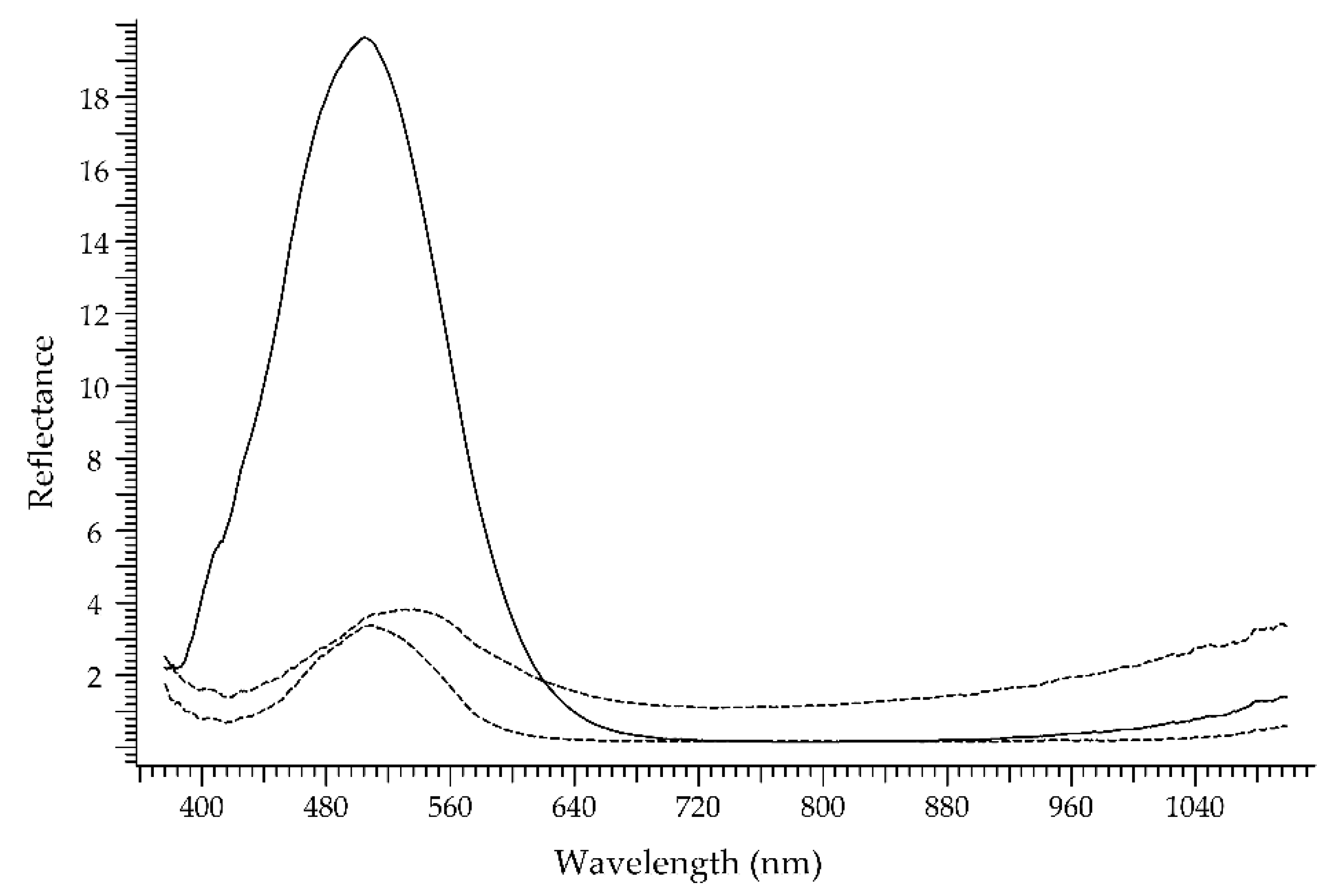


| Element | 8/Ori, 13/Ori, 23/Ori, 24/Ori and 30/Ori | 10/Ori | 20/Ori | Type I 1 | Type II 1 | Type IV 1 | Type V 1 |
|---|---|---|---|---|---|---|---|
| SiO2 | 32.8–42.8 | 61.13 | 47.73 | 36.0 | 37.3 | 41.2 | 41.5 |
| FeO | 27.8–41.7 | 12.61 | 16.83 | 37.5 | 32.1 | 12.7 | 8.9 |
| Al2O3 | 16.2–19.9 | 13.03 | 25.37 | 20.8 | 21.5 | 23.1 | 21.6 |
| MgO | <LOD | <LOD | <LOD | 4.4 | 6.2 | 16.3 | 19.8 |
| CaO | 0.6–5.9 | 3.04 | 6.71 | 0.7 | 1.4 | 5.4 | 4.3 |
| MnO | 0.3–2.1 | 0.45 | 0.40 | 0.4 | 1.2 | 0.4 | 0.3 |
| Cr2O3 | 0–0.2 | <LOD | 0.04 | 0.0 | 0.1 | 0.0 | 2.2 |
| TiO2 | 0–1.2 | <LOD | 0.60 | 0.0 | 0.0 | 0.4 | 0.5 |
| CuO | 0–0.4 | 1.39 | <LOD | 2 | 2 | 2 | 2 |
| NiO | 0–0.04 | 1.95 | 0.02 | 2 | 2 | 2 | 2 |
| Y | 0–0.06 | <LOD | 0.013 | 2 | 2 | 2 | 2 |
| Element | 8/Ori |
|---|---|
| SiO2 | 49.0 |
| PbO | 29.0 |
| CaO | 3.4 |
| SnO2 | 2.5 |
| K2O | 2.4 |
| Cl | 1.9 |
| CuO | 1.5 |
| FeO | 0.90 |
| Al2O3 | 0.3 |
| Sb2O5 | 0–0.04 |
| Item Analysed | Au | Ag | Cu | Fe | Pb | Zn |
|---|---|---|---|---|---|---|
| 8/Ori | 92.3 | 5.2 | 1.6 | 1.3 | 0.0 | 0.0 |
| 9/Ori | 91.7 | 7.2 | 1.1 | 0.2 | 0.0 | 0.0 |
| 10/Ori | 92.2 | 7.1 | 0.7 | 0.1 | 0.0 | 0.0 |
| 11/Ori | 91.2 | 7.7 | 1.1 | 0.1 | 0.0 | 0.0 |
| 12/Ori | 91.4 | 7.4 | 1.3 | 0.2 | 0.0 | 0.0 |
| 12/Ori screw | 88.8 | 8.7 | 2.5 | 11.5 | 0.6 | 0.0 |
| 12/Ori screw core | 86.1 | 4.6 | 9.3 | 2.8 | 19.2 | 1.6 |
| 12/Ori screw inside c | 88.4 | 8.6 | 3.0 | 9.1 | 0.3 | 0.0 |
| 12/Ori screw head | 88.9 | 9.2 | 1.9 | 0.3 | 0.0 | 0.0 |
| 13/Ori | 94.5 | 4.1 | 1.4 | 0.1 | 0.0 | 0.0 |
| 14a/Ori | 93.6 | 3.3 | 3.1 | 0.7 | 0.5 | 0.0 |
| 14b/Ori | 93.0 | 3.4 | 3.6 | 0.2 | 0.0 | 0.0 |
| 15a/Ori | 85.0 | 10.3 | 4.7 | 0.6 | 0.0 | 0.0 |
| 15b/Ori | 87.1 | 10.8 | 2.1 | 0.0 | 0.0 | 0.0 |
| 16/Ori ring | 86.4 | 12.0 | 1.5 | 0.1 | 0.0 | 0.0 |
| 16b/Ori pendant | 89.6 | 6.5 | 4.0 | 0.5 | 0.0 | 0.0 |
| 16b/Ori pendant | 91.4 | 5.8 | 2.9 | 0.2 | 0.0 | 0.0 |
| 16b/Ori pendant | 91.3 | 6.5 | 2.2 | 0.2 | 0.0 | 0.0 |
| 17a/Ori | 92.2 | 5.8 | 2.0 | 0.3 | 0.0 | 0.0 |
| 17b/Ori | 92.2 | 5.7 | 2.0 | 0.2 | 0.0 | 0.0 |
| 18/Ori | 75.5 | 22.6 | 1.8 | 0.0 | 0.0 | 0.0 |
| 19/Ori | 84.4 | 12.0 | 3.6 | 0.8 | 0.0 | 0.0 |
| 20/Ori | 81.4 | 15.6 | 3.0 | 0.1 | 0.0 | 0.0 |
| 21/Ori | 84.4 | 12.0 | 3.6 | 0.5 | 0.0 | 0.0 |
| 22/Ori | 83.8 | 13.0 | 3.3 | 0.2 | 0.0 | 0.0 |
| 23/Ori | 86.7 | 5.4 | 7.9 | 0.3 | 0.0 | 0.0 |
| 24/Ori | 83.5 | 12.3 | 4.2 | 0.1 | 0.0 | 0.0 |
| 25/Ori | 86.0 | 12.4 | 1.6 | 0.1 | 0.0 | 0.0 |
| 25/Ori cartouche edge | 88.5 | 9.9 | 1.6 | 1.1 | 0.0 | 0.0 |
| 25/Ori inscription | 84.7 | 12.1 | 3.3 | 1.9 | 0.0 | 0.0 |
| 26/Ori | 83.5 | 11.5 | 5.0 | 0.3 | 0.0 | 0.0 |
| 27/Ori | 90.2 | 9.1 | 0.7 | 0.5 | 0.0 | 0.0 |
| 28/Ori | 87.3 | 9.8 | 2.9 | 1.1 | 0.0 | 0.0 |
| 29/Ori | 95.6 | 3.7 | 0.7 | 0.1 | 0.0 | 0.0 |
| 30/Ori | 82.8 | 11.8 | 5.3 | 0.6 | 0.0 | 0.0 |
Disclaimer/Publisher’s Note: The statements, opinions and data contained in all publications are solely those of the individual author(s) and contributor(s) and not of MDPI and/or the editor(s). MDPI and/or the editor(s) disclaim responsibility for any injury to people or property resulting from any ideas, methods, instructions or products referred to in the content. |
© 2023 by the authors. Licensee MDPI, Basel, Switzerland. This article is an open access article distributed under the terms and conditions of the Creative Commons Attribution (CC BY) license (https://creativecommons.org/licenses/by/4.0/).
Share and Cite
Aceto, M.; Calà, E.; Robotti, F.; Gil, J.P.; Castronovo, S.; Gulmini, M.; Labate, M.; Agostino, A. Non-Invasive Analyses of Italian “Ostrogothic” Jewellery: The Desana Treasure. Heritage 2023, 6, 1680-1697. https://doi.org/10.3390/heritage6020089
Aceto M, Calà E, Robotti F, Gil JP, Castronovo S, Gulmini M, Labate M, Agostino A. Non-Invasive Analyses of Italian “Ostrogothic” Jewellery: The Desana Treasure. Heritage. 2023; 6(2):1680-1697. https://doi.org/10.3390/heritage6020089
Chicago/Turabian StyleAceto, Maurizio, Elisa Calà, Francesca Robotti, Joan Pinar Gil, Simonetta Castronovo, Monica Gulmini, Maria Labate, and Angelo Agostino. 2023. "Non-Invasive Analyses of Italian “Ostrogothic” Jewellery: The Desana Treasure" Heritage 6, no. 2: 1680-1697. https://doi.org/10.3390/heritage6020089
APA StyleAceto, M., Calà, E., Robotti, F., Gil, J. P., Castronovo, S., Gulmini, M., Labate, M., & Agostino, A. (2023). Non-Invasive Analyses of Italian “Ostrogothic” Jewellery: The Desana Treasure. Heritage, 6(2), 1680-1697. https://doi.org/10.3390/heritage6020089








